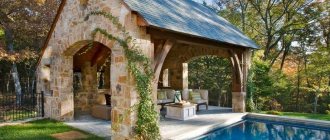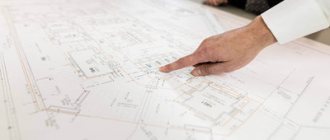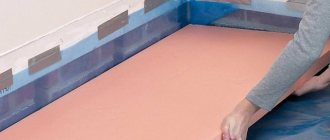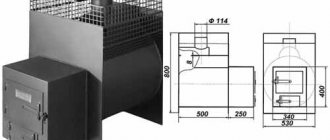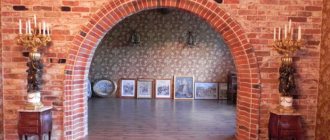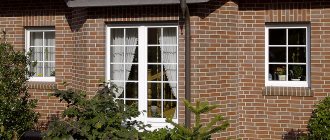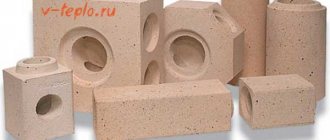This method is used not only for cladding the facade walls of various buildings; brick fences, gazebos and barbecues, and decorative architectural elements are also erected in this way. What is “Bavarian bricklaying”?
The best option for wall cladding is Bavarian masonry
How to choose material?
If you are planning to clad the facade of your house with Bavarian brickwork, then you should know that purchasing a batch of bricks from the nearest factory most likely will not help you.
For such finishing, multi-colored blocks are made. Color schemes may vary among different manufacturers. When selecting building materials for such foundations, you should look not only at their color, but also at other important criteria. Brick quality. Under no circumstances should the blocks have chips, deep scratches or other similar defects.
Damaged materials won't last long, so it's important to look for high-quality, damage-free products.
Uniformity of color. It doesn't matter whether you buy a light or dark brick
Both materials should have a uniform color, without pale or dark prominent spots.
Manufacturer. Buy only good bricks from reputable manufacturers. The most popular today are the plant in Stary Oskol, the LSR plants and the Golitsyn ceramics plant.
If we consider the specific parameters that a brick (for example, reduced) in Bavarian masonry should have, they are as follows:
- strength grade – not lower than M150;
- frost resistance level – not lower than F50;
- moisture absorption – from 8 to 10%.
How and from what is Bavarian brick made?
Bavarian type masonry bricks are produced using flash firing technology. It has existed for a very long time, it was used by our distant ancestors, who preferred to “blacken” the traditional building material made of red clay.
The designated technology consists of performing the following actions:
- At the moment when the formed block is placed in the furnace for further firing, materials with a high level of flammability, which contain a large number of organic components, enter through special hatches.
- Firing is carried out at a temperature of 1000 C. Reaching this limit, organic additives instantly burn out, forming soot, which colors the brick in the required color.
- The dyeing process occurs by redirecting carbons to the finished product. The procedure is carried out using gas flows, which set a strict direction for the organic soot.
Modern firing equipment is protected from excessive ingress of oxygen masses. In such an atmosphere, combustion promotes the formation of more organic elements.
The specific tones and shades of the brick will directly depend on the amount of carbon. The more there are, the more saturated and intense the color of the building block will be. If fewer organic elements are used, the brick has a light shade.
It is worth noting that flash firing technology does not involve the use of pigment dyes. This is because the dye is an inert compound that is not capable of reacting. That is why it is impossible to achieve the shade inherent in natural material.
Bavarian-type facing bricks are no different from standard facing blocks and comply with GOST requirements. The basis of the material is clay, to which various additives are added:
- leaning - inorganic components designed to facilitate the process of mass formation and reduce shrinkage (slag, sand, ash);
- burnable - organic elements responsible for reducing the density of the brick and increasing the porosity of the structure (sawdust, coal, peat);
- special – control the firing temperature;
- mineral - help to increase the density of the block structure, increase reliability and strength.
Brick laying scheme
During laying, you need to place materials of different shades nearby.
The Bavarian layout is based on the required positions:
- The bricks must be the same size.
- Do not place bricks of the same shade next to each other. It's better to take several options and create chaos.
The herringbone or pyramid pattern are more complex options, since you need to monitor from afar which bricks to lay and how to combine them. This type of block masonry is used to construct a fence. You can also decorate it with a fence. Brick fences can have a different surface; it can be smooth or corrugated. You can “play” with different colors and shades or make a fence to match the design of the facade.
Projects using Bavarian masonry are very popular, as such structures do not look boring. If you choose the right solution, you may not notice that the house is brick, because different shades and colors create the effect of a pattern on the walls. White Bavarian masonry, brown, red or any other color is most often used. Typically, the masonry pattern is laid on the first row, and then repeated through the row.
Getting a drawing
Bavarian brick can be embossed or smooth. Within the same object, two types of material can be used at once, but they cannot be mixed. Usually, with the help of smooth brick, individual elements of the object are highlighted, but the main cladding is done using relief masonry, or everything happens the other way around.
To create certain designs using Bavarian masonry, follow these rules:
- the first row should contain bricks of each color;
- their number of different colors should be approximately the same;
- distribute dark and light bricks evenly so as not to create a spotty effect;
- think about the design option in advance;
- choose colors carefully; if you combine contrasting shades, the effect can be unpredictable;
- drawings should not be symmetrical.
Bavarian masonry methods
Before you start laying bricks in the Bavarian style, you need to make a sketch. On paper you need to highlight individual fragments that will be done in a darker tone. It is also worth clearly drawing where which colors will be placed. Real professionals create several such sketches, and the customer determines which option suits him best.
Art Nouveau house with Bavarian masonry on the facade
Sketches of the “drawing” of Bavarian masonry
Even in ancient times, this technique was used for cladding buildings. Today, the availability of different shades of building materials allows us to significantly expand the possibilities. The main requirement, which has not changed for decades, is the creation of a harmonious pattern.
In the Bavarian style, corners, cornices and platbands can be done in one tone, and the walls in another. This approach gives the building a special touch.
Finishing the main walls with brickwork in a panoramic two-level house
An excellent option is two-color masonry. With this type of work, a specific mosaic is created, which only at first glance seems simple. In fact, the finished work looks amazing.
Light Bavarian masonry, the photo of which gives a real idea of the future look, allows you to emphasize the sophistication of taste. It looks more noble and elegant.
A bright house of classical construction with Bavarian decoration of external walls
Multicolor Bavarian masonry involves the use of five to eight different shades. With this technique, you can use both bricks of the same shade and contrasting products. Experts recommend first depicting this look on paper so that the final effect is as planned.
Brayer brick, the use of which makes Bavarian masonry look “aged”, creates harmony in the entire courtyard of a private house. In the hands of a master, this material takes on a completely different meaning. It is like the brush and paints that a successful artist uses to create his masterpiece.
Bright multicolor Bavarian masonry for a country house
Execution Rules
The facing brick used for such masonry can have both a smooth and textured surface.
The facing brick used for such masonry can have both smooth and textured surface. On the walls of one house you can combine products with smooth and corrugated surfaces, but you should not mix them with each other. Usually, parts of facades and frames of door and window openings are made from corrugated bricks, but smooth products are used for laying the main plane of the facade. The photo below shows a diagram of the Bavarian masonry:
From the photo you can formulate the rules of Bavarian styling:
- In the first row, bricks of all shades and colors are necessarily used. Products should be gradually alternated from lighter to darker shades.
- Bavarian masonry is characterized by laying wall elements with a spoon, shifting each row by half a brick. In this case, the vertical seam between the elements must coincide across the row.
- Elements of the same color cannot be placed on top of each other in adjacent rows.
- In each row, do not lay two bricks of the same color and tone in a row.
- The total volume of bricks of each color should be equal.
- When making houses from brick with Bavarian masonry, you must try to evenly distribute wall elements of different colors along the plane of the facade so that light and dark spots do not form.
- Before doing the work, it is worth considering in advance the styling options using all the colors. It is enough to make about 10 different brick layouts, which can then be alternated when cladding the building.
- When choosing a color scheme, you should not use very bright and contrasting shades, since the facade will ripple too much and will not be perceived as a single plane.
- When forming a pattern, you should not strive for symmetry, since when looking at the tiled façade, you should feel a sense of chaotic laying of bricks of different colors.
Wall design with Bavarian masonry
There are two main designs that are used when using Bavarian brickwork. The first and second methods are based on transitions from one color to another. If you make a brick wall of different colors and shades, a work of art will be created. In this case, a clear geometry of the drawing is necessary. Sometimes when you see such a wall, it begins to “ripple in your eyes.”
Choosing a clear installation scheme
In the first case, Bavarian masonry is carried out according to a clearly drawn pattern with the choice of a suitable pattern and color. Two main colors are taken, which are diluted with a couple more shades. The result is four colors. You should think about a good combination so that the colors are not uniform, because such a combination of bricks will no longer be Bavarian. In the photo you can choose the most suitable brick laying scheme using different shades.
Chaotic layout
In this option, there is no clear pattern for laying the bricks, but you must ensure that different colors alternate with each other. If you adhere to this principle, you can get a gorgeous picture of the facade. The transition from one shade to another should be smooth. In this option, you can even use up to eight different colors that are close to each other.
Character traits
Aesthetic and fashionable Bavarian masonry is recognizable and in demand. If you are planning to turn to this bright combination of multi-colored bricks, then you should find out what characteristic features are inherent in it.
- In this masonry, adjacent blocks usually have different colors.
- In the design, none of the colors should be accentuated against the others. Do not forget about this important rule, since if it is not followed, the masonry will turn out disharmonious.
- The pattern of such masonry should not be constantly repeated.
- The vertical seams should match across the row.
It should be noted that the traditional type of Bavarian masonry involves a combination of red and brown bricks (one of their shades). There can be no more than nine tones. Basically, masters resort to using eight suitable tones.
This is interesting: Blue furniture in the interior (20 photos): interesting combinations
Choosing bricks and tools
So, if you decide to decorate your house with a chaotic pattern of Bavarian masonry, then you should move on to choosing bricks and tools. Today there is a wide selection of types of bricks. In addition to shades, they differ in relief, internal properties, and parameters.
For Bavarian masonry, perfectly smooth brick without scratches or chips is suitable. The only exception may be relief brick, but when using it, you should not place two elements of the same color next to each other - this will mix the two colors and remove the effect of contrast.
It doesn't matter what type of brick you use. Whether it is clinker brick or ceramic brick, it must meet the following characteristics:
- Strength – M150;
- Frost resistance – F50;
- Moisture resistance – 8-10%;
- Thermal conductivity – 0.51.
In fact, designing patterns for Bavarian masonry is a very creative and entertaining endeavor. If you follow basic design rules, you can end up with a unique ornament that will create an individual and sophisticated interior.
If you have already chosen a brick, you can start selecting tools to get started. Here are the most necessary ones: construction cord;
- a tape measure or folding meter will help take measurements at each stage of cladding;
- trowel – a tool for leveling and removing excess mortar;
- jointing gives the seams a certain shape and processes them;
- a hammer-pick will help cut the brick into smaller elements;
- mortar shovel - you can use it to stir the mortar in the box, as well as serve and spread it on the wall;
- mopping is used to clean smoke and ventilation ducts from solution residues, as well as to smooth seams;
- a wooden square, with the help of which the squareness of the corners being made is checked;
- building level to check the verticality of the masonry;
- The rule is used to check the front surface of the masonry.
With these standard tools you can do it!
So, the “Bavarian masonry” style is perfect for those who want to make ceramics the classic basis of their interior. Whether it is a fireplace, a swimming pool or an entire house, this type of masonry will add sophistication and individuality to the building.
Step-by-step instruction
After proper preparation, you can proceed to the construction of Bavarian brickwork. Let's consider step by step how the blocks need to be placed correctly.
- First you need to check whether all facade walls are horizontal. For this you need a plumb line. Check the position of the walls along their entire height, set marks on the foundation base with the preliminary arrangement of facing materials. Keep in mind that the smallest gap between the main wall and the finishing should be no less than the thickness of the insulating layer. If you do not lay the latter, then the indentation may be very small. All the cracks will then need to be filled with solution.
- Next, mark the location of the starting row of blocks. Please note that all blocks in the cladding must be intact and without damage. Lay out 1 row of Bavarian bricks. Start from one corner and gradually move to what is on the opposite side. There should be a gap of at least 8-10 mm between them.
- In order to monitor the size of the seam, you should purchase a special device in the store or make it yourself from a square profile.
- If there is not a whole brick at the end of the layout, then you will need to make the gaps a little wider. At one time, make a gap between adjacent brick blocks no more than 2-3 mm. If this nuance is not adhered to, then the discrepancy will be obvious. After about 20-25 bricks, it will be possible to remove them within 10 cm of size. This is usually sufficient in most situations. If adjusting the gap is too problematic, you can simply cut off part of the brick and then apply it to a less noticeable area.
- Remove any debris from the wall. Pre-arrange the scaffolding. You cannot do without them if the height of the finished base reaches 1.5-1.6 m. Scaffolding is usually made by wood craftsmen themselves. You can buy already assembled or rent metal structures. Everything here comes from the wishes of the home master.
- Now prepare the masonry mortar. It should consist of 1 part cement component and four parts sand. Liquid is added as needed. Make the solution a little thicker than for laying a simple red brick.
- Next, place a waterproofing layer on the foundation - sheets of roofing felt. The laying is done starting with 2 corners located on different sides. Line them up to a height of about 4-5 stripes. Always monitor the position of the corner bases using a level or plumb line.
- Each of the corners should have a width parameter of 4-5 bricks. As further work progresses, this value will be reduced by half a brick block. While you are practicing the corners, do not remove the installation row. It will still be removed during further masonry.
- Now stretch a construction cord or rope between the aligned corners. Be sure to check that it is perfectly horizontal. Install strings to control the level of the masonry.
- Then you can proceed directly to laying one brick at a time. Take these parts from the previously laid installation row and lay them directly on the masonry composition. Adjust the joint width parameter using square metal rods.
- Any solution found on the front part will need to be removed immediately with a damp cloth. Move the rod along the rows as they increase. Remember that it is better to choose the color of each subsequent brick in accordance with the previously drawn up plan/scheme, if you have chosen this method. In this case, blocks do not need to be counted. It is enough to adhere to the approximate color ratio.
- When laying bricks, do not forget that the main color should account for approximately 50% of the entire masonry. You can alternate different colors if you wish. It's not scary to make a mistake in this matter.
- Then, after 4-5 rows, proceed to grouting the joints. This is done using a small device made of plastic, wood or metal. If during the grouting process you notice any gaps in the composition, then it should be added and leveled again. Always clean the surfaces from dirt, otherwise the Bavarian bricks may have noticeable mortar stains that will be difficult to get rid of.
- Carefully lay out the bricks in the area of the openings. In this case, it is often necessary to cut blocks to length. Cut materials should not be placed at the corner of the opening. Place it several blocks earlier.
- To make the brick finish more reliable and durable, it needs to be “tied” to the load-bearing wall base. To do this, you need to stock up on special reinforcement with a periodic profile, a metal mesh or a galvanized strip with perforation.
- If the bricks run along the entire facing surface, continue laying according to the old pattern until the work is completed. Of course, if you want to organize the specified masonry only in certain areas of the building, then you will need to act according to a pre-compiled and detailed sketch.
Proceed carefully and take your time. Always check the levelness of structures. You can use a bubble or laser level for this. If you doubt your skills or are afraid of making serious mistakes, then it is better to turn to the services of experienced masons. Then the result will definitely not disappoint you.
To learn how to properly make Bavarian bricklaying, see the following video.
Bavarian masonry - work for professionals
The best option for Bavarian masonry is a professional approach to work. In order for the whole process to be painless, you should seek help from a construction company. High level professionals:
Harmonious fusion of house and fence using the same Bavarian masonry pattern
will help you decide on the masonry pattern. The craftsmen will select the ideal brick placement option that will completely suit you;
will create individual sketches, strictly observing your wishes;
Excellent combination of dark and terracotta shades of finishing bricks
calculate the required number of bricks. When using Bavarian masonry, more than one shade is used. Correct calculation allows you to purchase the required amount of material and prevents the purchase of unnecessary products;
Classic brick house with Bavarian masonry
will provide assistance in purchasing materials. With the help of a specialist, choosing high-quality material is much easier;
Country house with perfect Bavarian masonry finishing
They will do all the work quickly and efficiently. Entrust the work to the masters, and they will do it efficiently.
True professionals will approach the solution of the task assigned to them with knowledge of the issue. They will complete the façade cladding as required by the customer. The craftsmen will always be happy to help you decide on the color scheme and select the most advantageous composition of shades. In addition, specialists will skillfully lay the brick, strictly following the sketch. In their hands, a simple cladding will turn into a beautiful ornament, emphasizing the individuality and excellent taste of the owner of the house.
Multi-colored bricks for Bavarian masonry with an aged effect
Bavarian masonry has been used for many decades. There was a time when the unique style was forgotten and was not particularly popular. But today everything has changed. She became in demand again. And this happened thanks to the presence of the color range of bricks. A subtle design solution allows you to create real masterpieces. You can admire such structures for hours, looking at the sophisticated patterns and ornaments.
Bavarian masonry on the facade with an advantage of light shades of brick
A small section of a brick fence using Bavarian masonry technology
Garage façade decoration with Bavarian masonry
Yellow-steel palette of shades in Bavarian masonry
Gray-brown tones of brick trim will add severity to the design of the building
What it is
Before you undertake the independent construction of aesthetic Bavarian masonry, you should analyze in detail what it is. Bavarian masonry is a type of brickwork in which different types of blocks are combined. The elements usually have different colors, most often in red and brown shades. The result is a very original and attractive composition that attracts a lot of attention.
Most sources are replete with information that this type of brickwork originates in Germany in the 17th century. In fact, these finishing materials are relatively new. They were able to gain significant distribution only a couple of decades ago. From the above information, an obvious question arises: what does Bavaria appear in the name of the brickwork have to do with it? This designation is considered more of a trade designation, such as a block house or a hamburger. The connection with the mentioned region in Germany is rather due to the fact that it is there that it is possible to see large numbers of old brick houses without plaster finishing.
Laying methods
A more effective result is achieved when using pre-thought-out layout sketches.
To perform Bavarian masonry, you can use one of the following methods:
- If you take pallets with an equal number of bricks of different colors and shades and lay them, taking a product in turn from each pallet, you will get a beautiful chaotic pattern, as is typical for Bavarian masonry.
- The second installation method involves the use of pre-designed patterns that will alternate when facing the house.
When performing masonry using the first method, work must be carried out in such a way as to constantly use elements from all pallets. You should avoid placing items of the same color alternately. Also, elements in adjacent rows should not be repeated in color.
A more effective result is achieved by using pre-designed layout sketches. To avoid symmetry and repetition, you need to prepare at least 10-12 layout options, and then alternate them when performing work. Thus, the likelihood that there will be identical layout options in one or adjacent rows is reduced to zero. As a result, we will get a chaotic masonry.
Nuances of brick façade cladding technology:
- It is worth leaving a ventilation gap 3-4 cm wide between the load-bearing wall and the cladding layer. To increase the thermal insulation of the house, insulation can be placed in this space.
- The layer of facing brick must be connected to the walls of the house using galvanized punched tape, spiral nails or wire.
- If the masonry of walls and the facing layer is carried out simultaneously, then bonded rows are used to tie them together. They are done every 4-5 spoon rows. Another option can also be used, when some elements are stacked with a poke in each spoon row.
- To ensure effective ventilation of the walls of the house under the finishing layer, ventilation gaps must be left. To do this, every fourth element in a row is laid without filling the joint vertically with mortar. The resulting hole is filled with loose insulating material.
Preparation
If you have secured all the necessary tools and building materials, then you can begin installation work. The first step is preparation. Let's consider what such events mean.
- Selection of drawing. There are many shades of Bavarian brick, but it is advisable not to place more than four on one wall base. The more flowers there are, the more difficult it will be to make the masonry. To make the façade original and attractive, 3-4 shades are enough. You can try to combine different colors using specialized programs, but experts do not recommend doing this, because you will waste time. None of the masons adheres to the perfectly precise location of each individual block.
This is what Bavarian masonry is characterized by. There is no specific alternation of bricks - there are no clear ornaments here. At the preparatory stage, decide on the main tone and a couple of additional ones. Do not forget that the main shade should occupy at least 50%. Others can be purchased in free proportions.
If you are unable to independently choose the main and secondary tones for Bavarian brickwork, then you can turn to designers who are more experienced in these matters or consider a number of ready-made options.
- To lay the bricks as quickly as possible, you can roughly lay out blocks of different shades directly on the scaffolding. There is no need for exact calculations here. If necessary, each color can be added later.
- Bavarian masonry must be constructed exclusively for jointing, which is why it is so important to purchase the required tools and devices in advance.
- If you wish, you can purchase a special color composition. It is more expensive than simple compositions, but it produces more interesting and beautiful brickwork.
Bavarian masonry can be used both as a facing layer for the facade of a building and as an outer row of brick wall bases. During individual cladding, it is allowed to use foam boards in order to further insulate the walls. However, not all experts advise turning to such solutions, because then the insulation will not be of much use, because it will be freely located between the load-bearing wall and the cladding, and this will lead to heat losses.
If you want to achieve a good thermal effect, place the insulation tightly between the base and the cladding. Fill the remaining spaces with foam.
Preparatory activities
Before giving step-by-step masonry instructions, let's consider several features of Bavarian masonry.
- Selecting a picture. There are many shades of Bavarian brick, but we do not recommend using more than four on one wall. The more shades, the more difficult it is to lay bricks, the more time it will take to find the right colors. Practice shows that 3-4 shades are quite enough to give façade walls an original look. On the Internet you can find recommendations to develop color alternations using special programs. You shouldn't go this way, don't waste your time. None of the professional masons adheres to the exact location of each brick.
An example of a Bavarian masonry scheme
Bavarian masonry, by the way, is different in that there is no exact pattern in the alternation of different bricks; it is not a strict geometric pattern. Decide on a main tone and two or three additional ones. The main tone must be at least 50%, the rest can be selected in arbitrary proportions. If it’s difficult to choose the main tone and additional ones that go with it, contact the designers or look for options on the Internet. When purchasing bricks, the number of shades must correspond to the percentage of each tone. With this in mind, calculate the materials needed before visiting the store.
Brick “Bavarian masonry Vanilla”
- To speed up the laying, roughly arrange bricks of different colors on the scaffolding. There is no need to count accurately; each color can be added if necessary.
- Bavarian masonry is done only for jointing; prepare all the tools and equipment. We will tell you what you need to have in the article below.
Laying is done under jointing
- If you wish, buy a colored solution. It costs a little more, but the money spent is justified by the significant improvement in appearance.
Bavarian masonry can be used as separate cladding or as the outer row of a brick wall. During separate cladding, you can use foam boards to insulate the wall. But we do not recommend using this method of insulation; its actual effectiveness is far from expected. The fact is that foam slabs lying freely in the space between the load-bearing wall and the cladding do not interfere with the thermal convention of air, which is what leads to the main heat losses.
Insulation of walls outside
To eliminate convection, you need to additionally tightly fill the space between the foam and the walls with liquid foam. This significantly increases the cost of construction work.
Foam insulation
There is another method of insulating facade walls for cladding with slabs - plaster the wall, glue or fix the slabs with dowels, seal the gaps between them and only then begin cladding with Bavarian bricks. But this method also increases financial losses significantly. From an economic point of view, it is better to insulate such walls from the inside of the premises.
This is interesting: How to lay facing bricks - useful to know
Practical recommendations
The depth of jointing has its own characteristics. Deep jointing perfectly hides existing unevenness and minor flaws in the shadow. Do it for ordinary mass. But in Bavarian masonry, white jointing is often used; it gives the façade of buildings an exclusive look. The shadow for white paneling is not a helper, but an enemy; it smooths out the contrast of the facade design. Keep this in mind, white jointing cannot be made deep, maximum 1–2 mm. This automatically means that the seams must be perfectly even and without gaps; the slightest problems are visible on a white background.
How to joint joints in brickwork
Correct and incorrect types of seams
Light masonry mortar
Dark masonry mortar
There are cases when developers, due to inexperience or in order to save money, buy low-quality bricks. The best option is to take several bricks before purchasing, lean them one by one against each other with all their edges and check the gaps and variation in size. But if low-quality material has already been purchased, then you will have to learn to work with it. This needs to be laid using a slightly modified technology.
What to do if the brick has uneven edges
- The thickness of the fresh mortar should be approximately two centimeters, in which case the width of the seam between the rows will be approximately a centimeter. Therefore, a new device must be made to control the height. You can use ordinary even pieces of boards 20 mm thick. Using small self-tapping screws, screw them in a T shape, one edge will rest against the top plane of the bricks, and the second against the side. When moving the device to a new place, be sure to use a trowel to trim the area where the fresh mass adjoins it, otherwise it will move. Then, when grouting the joints, more effort will be required.
- Place the brick on the fresh mass, press it down a little, check the position. The side edges may be so uneven, but it will not be possible to align them perfectly; give the brick a middle position. Be sure to place the thick edge of one brick next to the thick one of the neighboring one, level the horizon with the thickness of the mortar using at least three bricks at a time, and not one at a time. When leveling, never hit the edges of the bricks, only knock in the middle. If you don’t do this so that the bricks will lift the opposite side, you will have to remove them, remove the old mortar and repeat it all over again. In this way, you can even use bricks that have saber-curved edges. Constantly visually monitor the appearance of the seam and immediately remove any mortar that appears with a trowel. Laying, of course, will be done more slowly, but this is the price for saving money or inattention.
Do-it-yourself bricklaying
- Insert an ordinary metal rod measuring 10 mm and finally press down the brick. Check the position with a level in two planes. While the mortar is soft, place an even strip edgewise on the outer corner of the bricks (verst) and lightly tap it to level it, the edges of the bricks will move in one line. As you can see, during laying you will have to use two devices with different thicknesses, otherwise you will never be able to align the defective bricks. If everything is done correctly, then only a professional craftsman will be able to distinguish defective bricks from quality bricks on finished Bavarian masonry, and then only after careful examination at close range. Do the jointing with a minimum recess, the bricks are uneven, there is no need to open their planes.
Facing brick
If you strictly follow the Bavarian masonry technology, the facade will not only be beautiful, but also durable. Never rush to do the work, remember that correcting mistakes in any case takes more time than careful masonry. It is impossible to describe all possible cases in one article; learn to make independent decisions; the more practical experience you have, the easier it is to solve the difficulties that arise.
Wall cladding
High-quality Bavarian masonry
As practice has shown, Bavarian masonry is very popular among consumers
Photo of a house made of Bavarian masonry bricks
Prices for facing bricks
Facing brick
Choice of colors
The overall impression of Bavarian masonry largely depends on the correct selection of the color of the joints.
When choosing a facing brick, or rather its shades, designers advise first choosing the main color. After that, a similar color is chosen to pair with it, only a tone or two lighter or darker. You can choose a contrasting shade as a pairing color. After this, the remaining colors are selected as shades of these two color schemes.
As a rule, manufacturers of facing bricks usually offer ready-made mixtures for mortars. In this case, you can choose the color of the solution from a wide range of colors. When choosing the color of the material and mortar, do not forget that they should be in harmony with the shade of the roof and the filling of window and door openings.
If you decide to use facing bricks to decorate the facade, Bavarian masonry is exactly what you need, because this installation method is quite simple, and if you have the necessary knowledge, it can be done with your own hands.
A wide range of colors and textures of facing bricks allows you not to adhere strictly to the Bavarian red-brown color of the facade. You can use other color combinations and texture combinations, but adhere to the following rules:
- You should not use several too bright and saturated colors, especially if the material has a glossy surface. In this case, the exterior of the building will look intrusive and tiresome.
- You can use products from milky to dark gray, but the main condition is that all colors should be muted. It is better to use a material with a matte texture.
- You should not combine cold shades with warm ones and vice versa. The color scheme of the facade must be the same.
- A rather effective design idea was the use of a combination of light shades of elements with one dark or contrasting product. For example, against the general background of gray or light beige elements, dark blue or rich yellow bricks look like a bright accent.
Color selection
It is very important to choose colors in advance. Experts recommend first deciding on the main color of the object.
And only then a secondary one is chosen to join it, it is either contrasting to the main one, or close to it. It all depends on the layout of the facility as a whole. Next, the remaining shades are selected in the required quantity, which are close to the first two. When choosing the color of bricks, you need to foresee the color of the joints in the masonry; it is this that affects how the structure will look in the future.
Often, manufacturers immediately offer a certain color range of materials and immediately a certain color of mortar for joints. Remember that the color of the walls should be harmoniously combined with the material and shade of the roof.
The picture should not be repeated. Color should be distributed in such a way as to create the impression of chaos, but it should be well thought out.
It is very important that the bricks are of high quality. However, some builders, either due to a desire to save money or due to lack of experience, purchase low-quality material
You can check it like this: take several samples before purchasing and place them one by one with all their edges against each other. Check the variations in sizes and the gaps between them. However, if you were unable to check in advance and have already purchased low-quality material, then you need to treat its masonry with special care.
Types and manufacturers
The classification of Bavarian brick is carried out taking into account various parameters:
- by surface type – “artificial aging” effect, smooth, relief;
- by color – brown, beige, red, etc.;
- by structure – solid, with voids;
- single, euro, double.
Ceramic blocks are manufactured by various factories. In Russia, the products in greatest demand are BRAER, Fifth Element, TERCA RED FLAME, Recke Brickerei, Slavyansky and Golitsynsky factories.
BRIER
The BRAYER brick factory is located in the Tula region and is considered the largest domestic manufacturer of building blocks for Bavarian masonry. Production is carried out on modern equipment. This guarantees exceptionally high quality bricks and compliance with the required environmental standards.
BRIER produces bricks of all formats, from 0.7 F (euro) to 1.4 F (one and a half). The company carefully controls production, extracts raw materials, develops and implements new technological features, which reduces costs.
The company offers consumers a wide range of colors, including mocha, burgundy, and oak bark. Popular options are with a corrugated surface, terra (with shallow depressions, antique effect), with white seams, and a classic smooth format.
Kaliningrad brick The fifth element
was opened in Kaliningrad in 2010. It didn't take long for him to become a leading ceramics company.
The success of the Kaliningrad manufacturer is explained by close cooperation with the international conglomerate KELLER HCW GmbH, the use of technological developments, and careful quality control. The products meet the norms and standards of the European and Russian markets and are characterized by an affordable price.
20 types of ceramic products are produced under the “5 Element” brand.
Solid brick TERCA RED FLAME
TERCA RED FLAME is the largest construction conglomerate in Estonia, specializing in the production of plastic molded ceramic products. Solid brick is recommended to be used for interior cladding and creating decorative interiors.
The products of the Estonian brand meet quality requirements and environmental standards. Consumers can choose the desired color from a large catalog of collections.
Slavic brick factory (Krasnodar region)
The company works closely with German manufacturers, adopting their experience and skills. Production is carried out on equipment from Germany, which is characterized by a high level of productivity.
The main feature of the company is the use of inhibition techniques. It involves applying several layers of clay (white or colored) to the brick. This significantly enhances the strength parameters of the blocks, increases their decorative function, and reduces the level of water absorption.
Bavarian brick from the Slavic Brick Factory is characterized by increased strength (M200) and a variety of colors combined into collections. The most popular are Provence RUST, ANTIQUE, Gothic, Milan.
Golitsyn ceramics plant (Moscow region)
The oldest manufacturer of ceramic products in Russia. The company is constantly modernizing, introducing technology, and developing new production methods.
The products comply with the quality standards established by GOST. The manufacturer produces an assortment of ceramic blocks that differ in the method of painting, surface type, and assortment. Consumers can order products in non-standard sizes.
Collections such as Bavaria, Old Prague, Milan, Venice and Country are in demand.
Stary Oskol Brick Factory (Recke Brickerei)
Produces premium engobed blocks. Recke Brickerei brand products are characterized by increased strength (M200, M250), low level of water absorption (maximum 6%), a variety of colors and solutions, including glossy shades, warm colors, etc.
The plant is equipped with modern equipment that allows you to control the production process at all stages. This guarantees exceptional product performance.
Slavic brick factory Krasnodar region
The plant is equipped with modern German equipment with high productivity. Production is carried out using plastic forming technology. Collections of façade ceramic bricks are distinguished by their unique style and new color schemes, giving the building a presentable appearance and bright individuality.
Hollow brick is presented only in the standard 1 SF format. The manufacturing technology uses the engobing method (applying a thin layer of white or colored clay with additives and dyes to the surface), which increases decorativeness and reduces water absorption to 8%. In addition, Slavic facing brick is characterized by increased strength (M200).
The Bricus catalog presents the following interesting collections: Provence (shades of blue), Hamburg (gray), Gothic and Milan.
- Provence smooth with engobing (unusual blue-violet color);
- Provence RUST (rustic surface with shallow wrinkles, less bright color compared to Provence);
- Provence BUNT ANTIQUE (gradient red-blue color, rustic surface with sand);
- Provence ANTIQUE (differs from the previous type only in its uniform blue color);
- Provence BUNT RUST (distinguished by the gradient color of the brick with a transition from red to blue);
- Hamburg RUST (has a gray background and a rustic surface);
- Hamburg BUNT (gradient color with a transition from dark gray to yak brown, smooth surface);
- Hamburg BUNT RUST;
- Gothic ANTIQUE (rustic surface with sand);
- Gothic smooth (bright combination of contrasting colors);
- Milan with engobing (each brick is unevenly painted in several colors, smooth surface);
- Milan with engobing taupe (smooth surface).
The retail price for the manufacturer's product does not exceed 20 rubles per piece, which makes the product very attractive, especially for cladding a private house.
